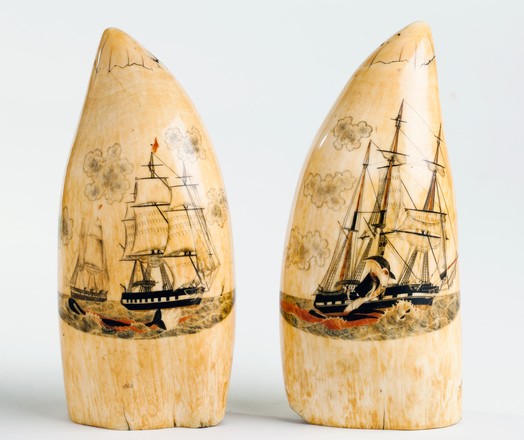Sperm whale's teeth scrimshaw
Artists unknown, c1800s
Ink on whale tooth
Bequest of Sir William Dixson, 1952
DR 40
Scrimshaw is the craft of carving pictures or patterns into bone, teeth, horn, shell or other suitable materials. While its origins are unknown, the technique became popular onboard whaling ships, where the tools, the materials and the time were readily at hand.
Scrimshaw features a wide range of images, often traced by pinpricking from books and journals. Especially common however are scenes of whaling and marine life. These examples show whalers at work. On one tooth, men in a longboat are harpooning a whale. On the other, a whale is being hauled onboard the ship, where its valuable blubber and skin will be stripped, or flensed.
Sperm whales are the largest
of all the toothed whales, measuring up to 18 metres in length and weighing up
to 60 tonnes. Sperm whales have tube-shaped bodies, small, paddle-shaped
flippers, a small, lumped dorsal fin and large triangular tail flukes.
A person who makes scrimshaw is known as a scrimshander.
The Latin name for the sperm
whale, Physeter macrocephalus,
translates to ‘blower with a big head’.
To create a piece of
scrimshaw, a sailor first scrapes and polishes the tooth or other material
smooth. The design is then incised into the surface using a sharp tool such as
a sail needle, awl or jack knife. Once the design is complete, the surface is rubbed
with ink, soot from the ship’s lamps, tar or even tobacco juice to push the
colour deep into the design. The scrimshaw is then wiped and polished again to
clean away the excess colour and reveal the image.
The Australian Whale Sanctuary was established
to protect whales and dolphins found in Australian waters. This zone includes
all Commonwealth waters from the three-nautical-mile state limit to the
boundary of the Exclusive Economic Zone (ie, out to 200 nautical miles and
further in some places).
Before the widespread moratorium on whaling, every
part of a whale had commercial use: whale meat was used for human, stock and
pet food; whale skin was used for luggage and other leather products; and whale
oil was used in the manufacture of margarine and cooking oils, as well as for
lamp fuel, lubricants and candles, and as a base for perfumes, soaps and
cosmetics. Baleen (whalebone) was used for items such as corsets, whips and
umbrellas.
Australia stopped the
commercial whaling of humpbacks in 1963, but continued hunting sperm whales until
1978. In 1986 the International
Whaling Commission established in an
international moratorium on commercial whaling.
Baleen whales have
baleen plates with bristles instead of teeth.
Whales can have up to around 250 teeth, but
some species have none.



 Back to list
Back to list